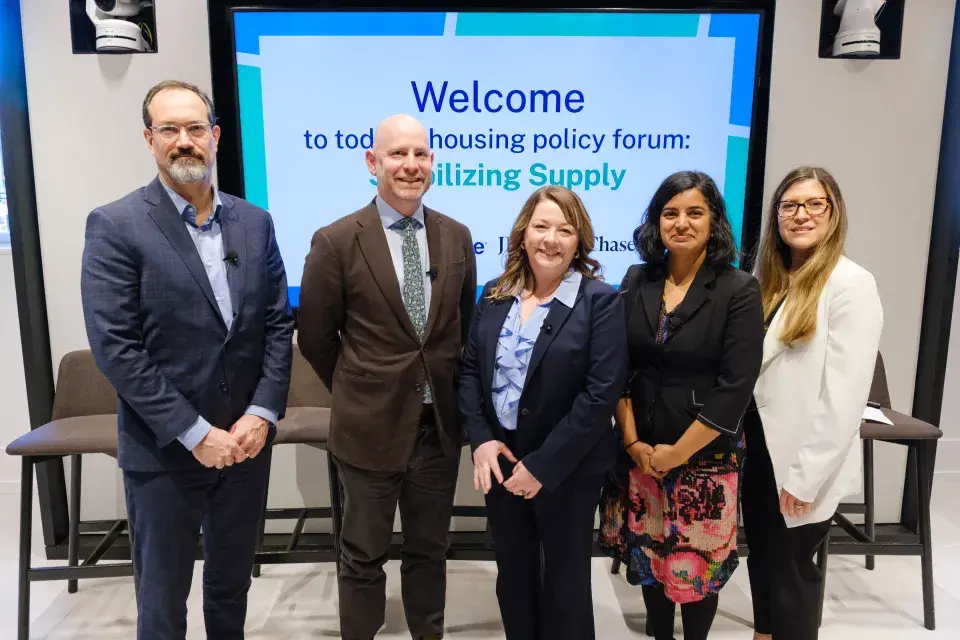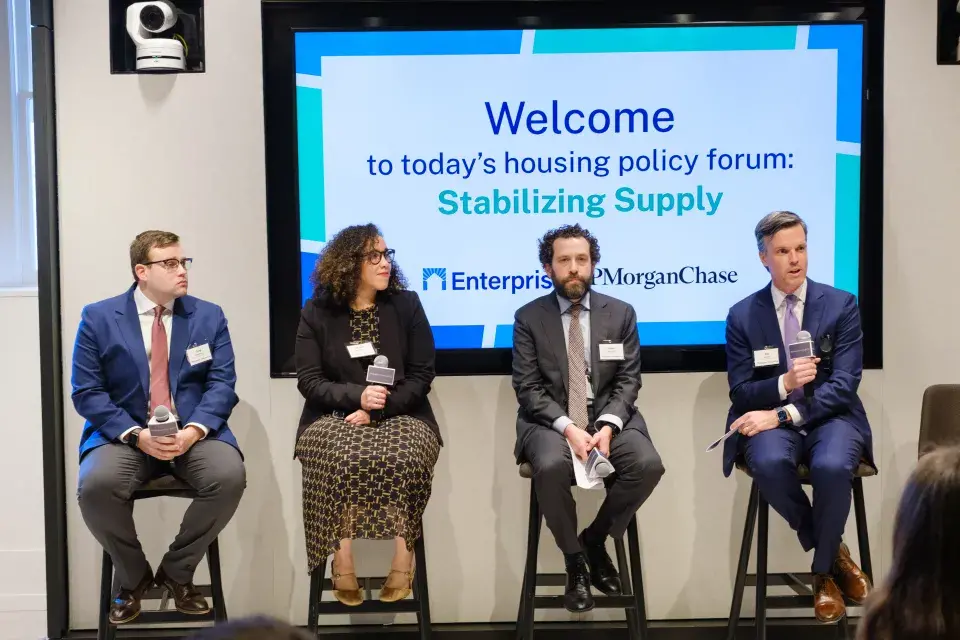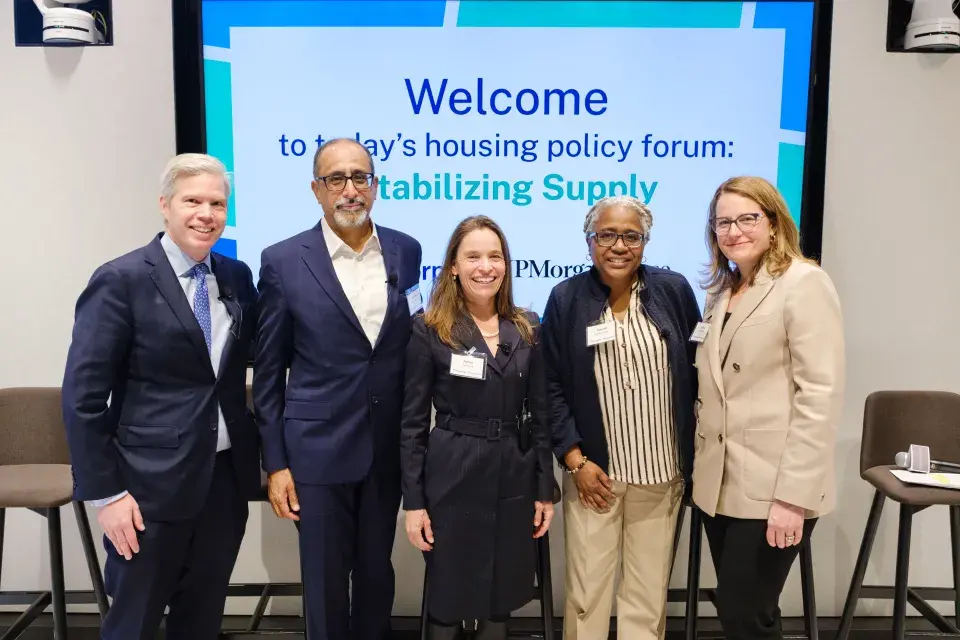Even as the affordable housing industry has been developing more accessible options for low- and moderate-income households, affordable housing owners and operators are struggling to maintain and preserve the units that currently exist. From the increasing frequency and severity of natural disasters to the growing property insurance crisis, operators are struggling to keep pace with rising operating costs and are faced with tough decisions on how to continue offering housing at affordable prices without jeopardizing the financial health and stability of their properties.
Enterprise and JPMorganChase recently gathered affordable housing policy, finance, and development experts as well as congressional staffers to discuss strategies to stabilize the affordable housing industry and preserve the housing that is currently serving nearly five million households across the country. The housing policy forum, Stabilizing Supply, which builds on last year’s convening, Scaling Supply Solutions, included a range of discussions about the state of the U.S. housing market for preservation and stability, as well as policy-, capital-, and practitioner-focused solutions to protect the nation’s affordable housing supply and residents who depend on it.
The forum opened with a fireside chat featuring Enterprise Senior Vice President for Programs Meaghan Vlkovic and Heather Higginbottom, Head of Research, Policy & Insights, Corporate Responsibility, JPMorganChase. Vlkovic began the conversation by sharing that approximately 10,000 of the 75,000 federally subsidized affordable properties in the U.S. could lose their subsidies by 2030. The discussion focused on the scale of the challenges, as well as the opportunities to combat the risks to affordable units. Below is an excerpt from Vlkovic and Higginbottom’s conversation.
H.H.: Enterprise has been advancing its work on affordable housing for over 40 years. You have your own portfolio of properties, what are you all seeing right now as it relates to preservation and stability in your portfolio?
M.V.: We are doing a number of things around capital, policy, and programming. To support our partners in distress, we created Partner Sustainability and Growth services. We have taken a cross-divisional approach by creating a community of practices across our asset management, investment, Solutions, policy, and Enterprise Community Development teams to support our organization and others in three areas. One, understanding what their needs are as an organization. The second is considering their pipeline. We know that activating the development pipeline is how partners in the field are able to actually do their business and sustain their organization. And third is their portfolio. How do we work collectively to bring technical assistance, pass through grants, lines of credit, and working capital to support those three pathways for our partners.
H.H.: We know that when we are talking about preservation that there is a huge amount of the nation’s housing stock that does not have any subsidy attached to it and is also at risk of a loss of investments. We have been proud to support some of the innovative work that you are leading from the research and policy perspective to look at the affordable unsubsidized stock, small and medium multifamily properties. Can you tell us about some of that work?
M.V.: SMMF or small-to-medium multifamily refers to properties with 2–49 units, though some jurisdictions classify properties up to 100 units as SMMF due to financial factors. This highlights resource gaps for smaller properties. Our research shows 80% of SMMF rental units are affordable to households earning at or below 80% of the local median income, making up over half of the affordable housing stock for this group. In partnership with JPMorganChase and others, we launched Preservation Next to help small developers and owners rehab and preserve properties affordably. Through virtual trainings, we provide expertise in real estate finance, property management, and capacity-building tools. Participants also receive predevelopment funds to advance projects. Additionally, Preservation Next shares research on public-private-philanthropic partnerships, recognizing their crucial role in creating gap financing and resources for preserving this housing stock.
H.H.: What do you want to see happen going forward in the housing industry and what do you want to leave the room with, today?
M.V.: Leaning on actions with our policymakers and really focusing in with our public partners at the state and local level to prioritize preservation, set-aside resources, and program creation, including capacity programming to support the development ecosystem across our markets. This is going to be really critical. One thing I want to mention is our partners who are permanent supportive housing providers, they are the most distressed right now. And we know our homelessness problem across the country is the worst we have ever seen. Enterprise is emphasizing how critical it is to sustain these organizations and their portfolios.
I also want to note some other action opportunities, including setting specific preservation priorities within city plans. Every year state housing finance agencies put out a qualified allocation plan for the resources it plans to distribute. It is an opportunity for organizations to weigh in, provide feedback, and advocate for prioritizing preservation. Additionally, we must collect and disseminate public information and data so that there's a capital program design that is aligned with each particular jurisdiction. We need to coordinate and facilitate collaboration between public, private, and philanthropic organizations and find ways to expand resources. That is especially important now, as we are seeing drastic cuts and terminations, it is a challenging moment.
But a bright spot is that there is strong and growing bipartisan support for Low-Income Housing Tax Credit (Housing Credit) expansion and we’re continuing to keep an eye on that. One item I did want to elevate related to preservation is eviction prevention, tenant protections, and right to cure. I'm based in Atlanta and Georgia recently passed the warrant of habitability last year, and it was the first time that they’ve had a warrant of habitability for residents and it’s also the first time that they’ve had a right to notice on eviction, for three days. This was an important win because it may have an impact on housing stability issues related to eviction filings going forward.
The fireside chat was followed by a presentation from Andrea Ponsor, president and CEO of Stewards of Affordable Housing for the Future (SAHF), who detailed the specific financial challenges that are destabilizing the affordable housing industry, such as decreased rent and rental assistance collection; insufficient reserve balances; and increased property insurance, staffing, maintenance, and security costs. This presentation set the stage for a series of expert panel discussions on policy and financial solutions to preserve and stabilize housing in rural, urban, and tribal communities.

Short- and long-term solutions discussed during the panels included:
- Solutions to address rising operating costs:
- Adjusting strategies for procuring property insurance to ease the impact of rising premiums on affordable housing owners and operators, such as changing renewal timelines or splitting up coverage across a greater number of carriers for lower costs.
- Expanding access to property insurance data and developing a guide for housing operators with best practices for sharing the actions they have taken to reduce risk at their property with their insurers. Additionally, tracking whether disaster mitigation measures taken by property owners are actually leading to any lower insurance premiums.
- Supporting owners and operators of permanent supportive housing who are disproportionately experiencing operational challenges, while urging policymakers to take action on the need for additional resources for funding supportive services.
- Prioritizing funding for resident services to ensure that tenants feel supported and know the steps they can take when they might have trouble paying their rent.
- Strategies to protect affordable housing against natural disasters:
- Implementing preservation- and resilience-focused requirements and incentives into state Qualified Allocation Plans and building codes, such as the FORTIFIED™ standard or Enterprise Green Communities criteria.
- Partnering with capital providers to access the necessary capital for retrofitting the nation’s existing and aging affordable housing stock with science-backed and proven approaches that mitigate that risk of extreme weather events.
- Financing-related solutions to stabilize affordable housing:
- Providing affordable housing developers with funding to acquire unsubsidized affordable housing and supporting smaller landlords who are trying to keep these units on the market.
- Creating and expanding access to capital products that are specifically for preservation and exploring new methods to encourage more private for-profit organizations to partner with non-profit and public entities on preserving affordable housing.
- Enacting federal policies such as the Affordable Housing Credit Improvement Act, which would strengthen and expand the Housing Credit so it can more effectively be used for preservation; the Neighborhood Homes Investment Act, which would create a tax credit to support the development and preservation of one-to-four-unit homes; and the Rural Housing Service Reform Act, which would halt the involuntary loss of rental assistance in USDA Section 515 properties with expiring mortgages.
- Communicating with Members of Congress the need for funding for HUD staffing and programs, such as the HOME Investment Partnerships Program and the Community Development Block Grant, in order to ensure that proposed tax policies can have their intended impact on affordable housing.





